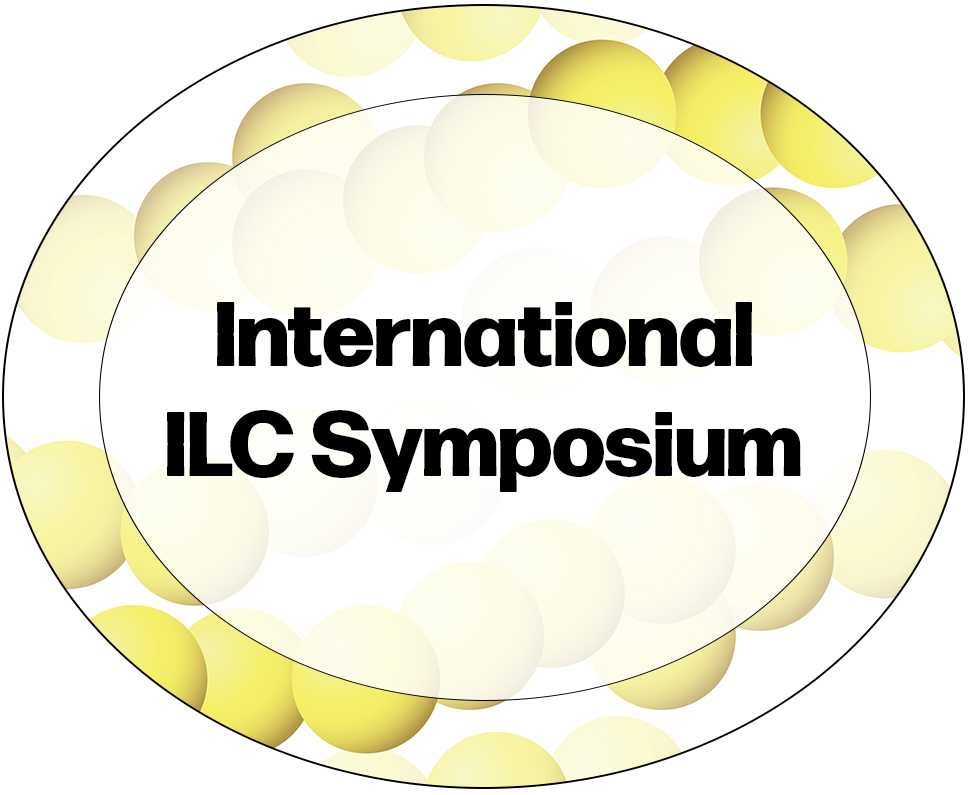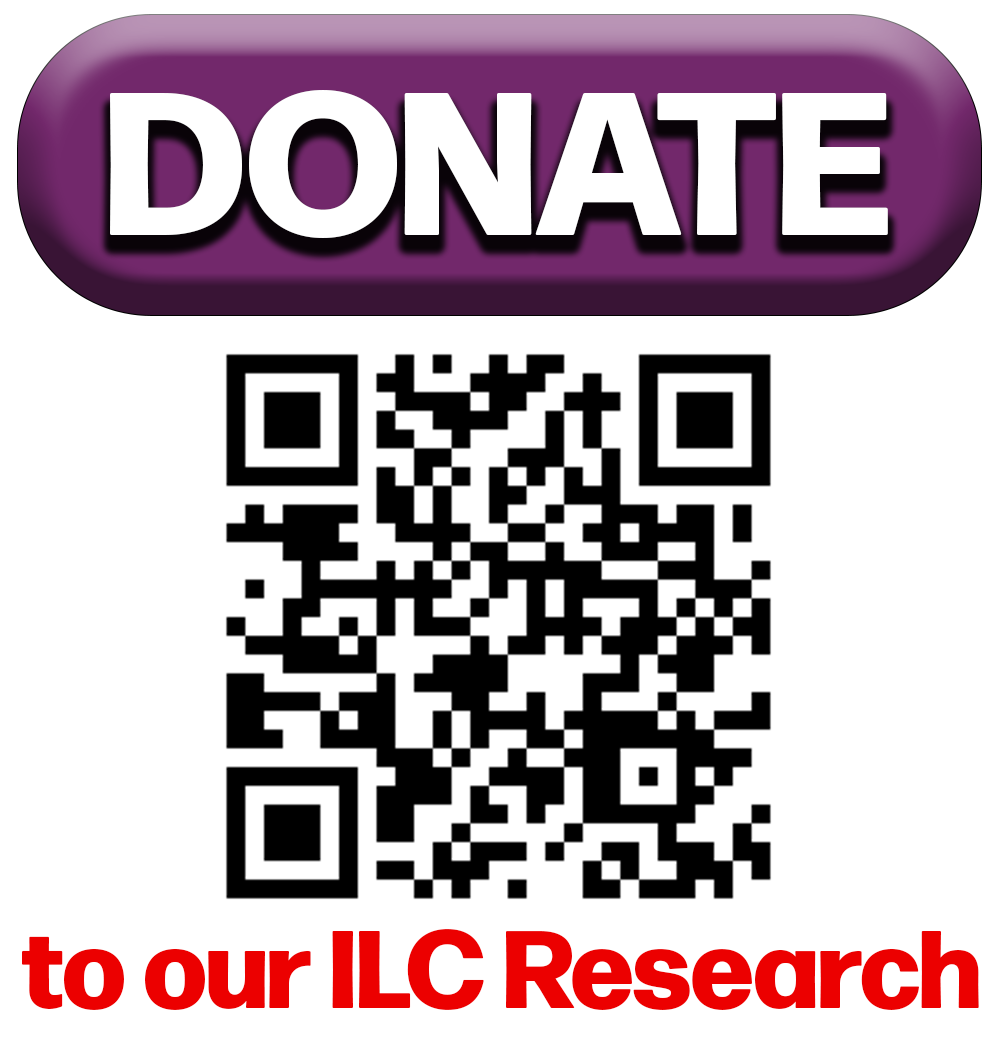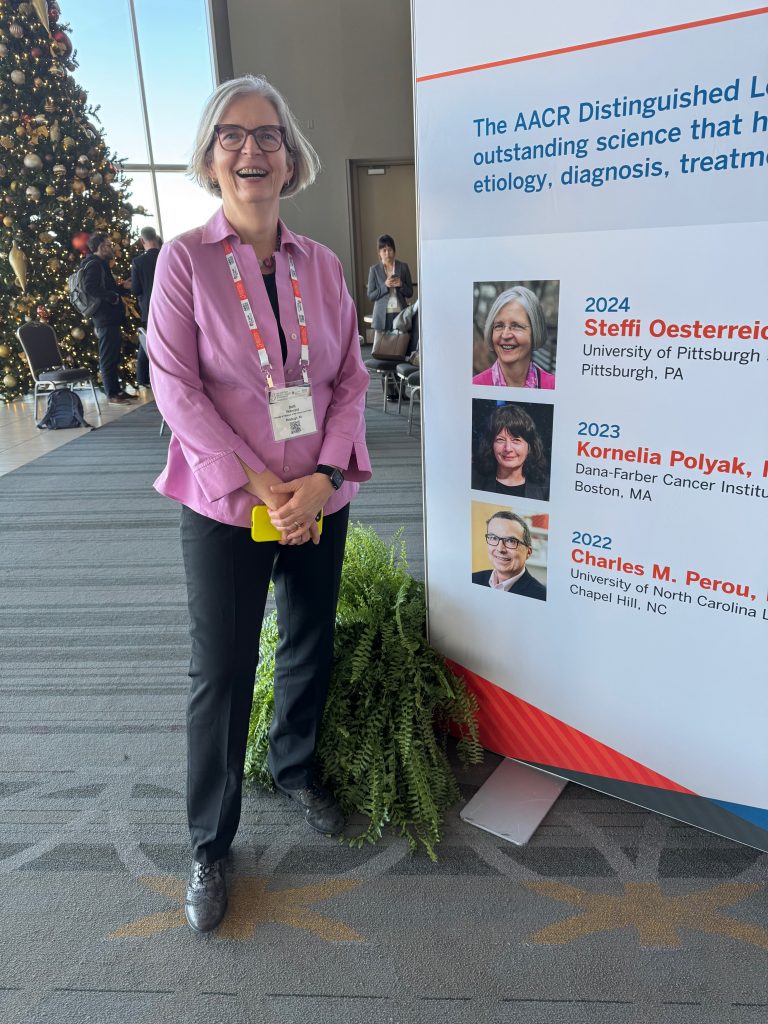Awards and Funding
Members of the Pittsburgh Invasive Lobular Carcinoma (ILC) Program of Excellence have received extensive recognition and funding for their pioneering work in ILC research. Below we highlight key faculty grants, industry partnerships, foundation support, and awards received by our team and trainees.
Faculty Funding for ILC Research
National Institutes of Health (NIH)
Drs. Steffi Oesterreich and Adrian Lee
R01 CA252378 (2021–2026)
Credentialing Models of Invasive Lobular Breast Cancer for Translational Research
Supplement (with Dr. Yi Li, Baylor College of Medicine, Houston, TX): Mutating E-cadherin in rats to model lobular breast cancer
Dr. George Tseng
R01 LM014142 (2022–2027)
Disease subtyping guided by clinical phenotype for precision medicine
Drs. George Tseng and Adrian Lee
R01 CA285337 (2025–2030)
Single-cell congruence evaluation and selection of cancer models toward precision medicine
Dr. Julia Foldi
KL2, University of Pittsburgh School of Medicine (2025–2028)
Liquid biopsy-guided tailoring of therapy in metastatic lobular breast cancer
Industry Collaborations
Our group partners with numerous biopharma and biotech companies to accelerate discoveries in ILC biology and treatment:
- AstraZeneca – Analysis of estrogen receptor action and turnover in response to SERDs in ILC
- PUMA Biotechnology – Study of ERBB2 mutations in ILC and response to anti-HER2 therapies
- Natera – Evaluation of Signatera data in primary and metastatic ILC and integration into clinical trials
- Illumina – Sequencing of primary and metastatic ILC tumors
- Caris Life Sciences – Real-world data analysis of HER2 mutations in ILC
- Foundation Medicine – Genomic profiling of ILC using large-scale real-world datasets
Foundation Support
Breast Cancer Research Foundation (BCRF)
Dr. Steffi Oesterreich has been continuously funded by BCRF since 2012 for studies on estrogen receptor action, endocrine resistance, and molecular drivers of ILC. Dr. Adrian Lee has received BCRF support since 2021 for his work on growth factor receptor signaling in ILC. BCRF also funds the annual BCRF ILC Symposia and the ILC Legacy Project, which supports the ILC Living Biobank.
Susan G. Komen Foundation
Drs. Adrian Lee and Steffi Oesterreich serve as Komen Scholars (since 2013 and 2016, respectively) supporting ILC research, including work in the Patient-Derived Organoid (PDO) and Hope for Others (HfO) programs. Dr. Rachel Jankowitz received a Komen Career Development Grant for the neoadjuvant ILC trial (TBCRC037).
Dynami Foundation
2020: Funding to study unique features of mixed ductal–lobular tumors
2022: Support for using Bionano sequencing to study DNA structural variants in ILC
2025: Dr. Julia Foldi received funding to apply spatial sequencing to pleomorphic ILC
METAvivor
Supported research (2021–2024) on mesothelial–tumor cell interactions as potential therapeutic targets in metastatic ILC.
Metastatic Breast Cancer Network (MBCN)
Funded early studies (2017–2019) identifying novel druggable pathways in metastatic ILC.
Conquer Cancer Foundation (ASCO)
Supported Dr. Nasrazadani’s work (2019–2020) on the clinical and molecular characterization of mixed invasive ductal–lobular breast cancers.
Magee-Womens Research Institute and Foundation
Since its establishment in 2010, the Foundation has provided broad support for ILC research, including biostatistics, equipment, and the HfO rapid autopsy program.
Shear Family Foundation
Provided sustained support for multiple ILC projects, including funding for Dr. Oesterreich’s Endowed Chair (2020) and the ILC Symposia.
A Glimmer of Hope Foundation
Supported the collection and analysis of liquid biopsies from patients with metastatic breast cancer, enabling discovery of genomic alterations in cfDNA from ILC patients.
Funding for Trainees
Rachel Jankowitz
CCR14300865 (2014-2020 in NCE)
A Trial of Endocrine Response in Patients with Invasive
Nilgun Tasdemir
NIH K99 CA237736 (2019-2021)
Non-Canonical FADD Signaling as a Genetic Driver of Invasive Lobular Carcinoma
Nilgun Tasdemir
CDMRP (2017-2020)
Investigating Models and Drivers Of ILC
Emily Harrington
NIH, F31 (2016-2018)
Targeting the EMT-Like Phenotype in ILC
Matthew Sikora
NIH K99 CA193734 (2015-2016)
Elucidating the Function of WNT4 in Endocrine Resistance in ILC
Kevin Levine
NIH, F30 (2017-2020)
FGFR4 as Driver of ILC Progression
Sreeja Sreekumar
DF14301091 (2014-2017)
Harnessing Altered Estrogen Receptor Turnover on Invasive Lobular Carcinoma for Improved Therapy
Awards and Honors
- Drs. Adrian Lee and Steffi Oesterreich – Terri L. Chapman Award (Susan G. Komen for the Cure; 2018)
- Drs. Adrian Lee and Steffi Oesterreich – PNC Elsie Hillman Distinguished Scholar Award (2018)
- Dr. Adrian Lee – University of Pittsburgh BGSA Distinguished Mentor Award (2018)
- Dr. Steffi Oesterreich – William E. Brown Outstanding MSTP Mentor Award (2019)
- Dr. Steffi Oesterreich – Theresa’s Leadership Award in Basic Research (2022) – for patient advocate involvement in ILC research
- Dr. Steffi Oesterreich – Merrill J. Egorin Excellence in Scientific Leadership Award (2022)
- Dr. Steffi Oesterreich – AACR Distinguished Lectureship in Breast Cancer Research (SABCS, 2024)
- Dr. Julia Foldi, Dr. Hannah Maynard, Abdalla Wedn – Lobular Breast Cancer Alliance Research ILC Research Abstract Merit Award (travel to the SABCS 2025)
Publications
Our research program, led by Steffi Oesterreich and Adrian V. Lee at the University of Pittsburgh and UPMC Hillman Cancer Center, focuses on understanding the unique biology of invasive lobular carcinoma (ILC) and translating these insights into improved diagnostics and therapies. We integrate molecular, genomic, and clinical studies through extensive collaborations with national and international partners to advance precision medicine for patients with ILC.
Estrogen Receptor Biology and Endocrine Resistance
Our research has long focused on how estrogen receptor (ER) signaling drives lobular breast cancer biology and contributes to endocrine therapy response and resistance. We have characterized unique ER-mediated gene expression patterns in ILC, uncovered the role of WNT4 and lipid metabolism in resistance, and identified mechanisms such as ESR1 fusions and NF1 loss that underlie acquired resistance. Together, these studies define the molecular diversity of ER function and reveal novel therapeutic vulnerabilities in endocrine-resistant ILC.
- Sikora MJ, et al. (2014). “Invasive lobular carcinoma cell lines are characterized by unique estrogen-mediated gene expression patterns and altered tamoxifen response.” Cancer Res 74(5): 1463–1474. PMID: 24425047
- Sikora MJ, et al. (2016). “WNT4 mediates estrogen receptor signaling and endocrine resistance in invasive lobular carcinoma cell lines.” PMID: 27650553
- Du T, et al. (2018). “Key regulators of lipid metabolism drive endocrine resistance in invasive lobular breast cancer.” Breast Cancer Res 20(1): 106. PMID: 30180878
- Bossart EA, et al. (2019). “SNAIL is induced by tamoxifen and leads to growth inhibition in invasive lobular breast carcinoma.” Breast Cancer Res Treat 175(2): 327–337. PMID: 30798422
- Sreekumar S, et al. (2020). “Differential Regulation and Targeting of Estrogen Receptor alpha Turnover in Invasive Lobular Breast Carcinoma.” Endocrinology 161(9). PMID: 32609836
- Shackleford MT, et al. (2020). “Estrogen Regulation of mTOR Signaling and Mitochondrial Function in Invasive Lobular Carcinoma Cell Lines Requires WNT4.” Cancers (Basel) 12(10). PMID: 33053661
- Yates ME, et al. (2024). “ESR1 Fusions Invoke Breast Cancer Subtype-Dependent Enrichment of Ligand-Independent Oncogenic Signatures and Phenotypes.” Endocrinology 165(10). PMID: 39207954
- Sokol ES, et al. (2019). “Loss of function of NF1 is a mechanism of acquired resistance to endocrine therapy in lobular breast cancer.” Ann Oncol 30(1): 115–123. PMID: 30423024
- Sottnik JL, et al. (2024). “WNT4 Regulates Cellular Metabolism via Intracellular Activity at the Mitochondria in Breast and Gynecologic Cancers.” Cancer Res Commun 4(1): 134–151. PMID: 38112643
E-Cadherin Loss, IGF1R Signaling, and Collateral Pathways
A hallmark of invasive lobular carcinoma is loss of E-cadherin (CDH1), which disrupts cell adhesion and profoundly alters cell signaling. Our team has shown that E-cadherin loss activates the IGF1R pathway, creating therapeutic opportunities, and that some ILCs without CDH1 mutations rely on alternative genomic or epigenomic mechanisms. We have also discovered cAMP/PKA/CREB pathway enrichment, underscoring how E-cadherin loss drives distinctive molecular rewiring in ILC.
- Nagle AM, et al. (2018). “Loss of E-cadherin Enhances IGF1-IGF1R Pathway Activation and Sensitizes Breast Cancers to Anti-IGF1R/InsR Inhibitors.” Clin Cancer Res 24(20): 5165–5177. PMID: 29941485
- Elangovan A, et al. (2022). “Loss of E-cadherin Induces IGF1R Activation and Reveals a Targetable Pathway in Invasive Lobular Breast Carcinoma.” Mol Cancer Res 20(9): 1405–1419. PMID: 35665642
- Dopeso H, et al. (2024). “Genomic and epigenomic basis of breast invasive lobular carcinomas lacking CDH1 genetic alterations.” NPJ Precis Oncol 8(1): 33. PMID: 38347189
- Logan GJ, et al. (2015). “Molecular drivers of lobular carcinoma in situ.” Breast Cancer Res 17: 76. PMID: 26041550
- Puthanmadhom Narayanan S, et al. (2024). “Transcriptomic analysis identifies enrichment of cAMP/PKA/CREB signaling in invasive lobular breast cancer.” Breast Cancer Res 26(1): 149. PMID: 39478577
Genomics, Transcriptomics, and Molecular Subtypes
Our integrative genomic and transcriptomic analyses have revealed the molecular diversity of ILC, distinguishing it from ductal carcinoma. We identified recurrent ESR1 and FGFR4 amplifications, characterized single-cell transcriptional heterogeneity, and contributed to spatial and computational studies of mixed and lobular-like tumors. This work continues to define ILC as a distinct and heterogeneous molecular disease.
- Ciriello G, et al. (2015). “Comprehensive Molecular Portraits of Invasive Lobular Breast Cancer.” Cell 163(2): 506–519. PMID: 26451490
- Cao L, et al. (2019). “Frequent amplifications of ESR1, ERBB2 and MDM4 in primary invasive lobular breast carcinoma.” Cancer Lett 461: 21–30. PMID: 31229512
- Levine KM, et al. (2019). “FGFR4 overexpression and hotspot mutations in metastatic ER+ breast cancer are enriched in the lobular subtype.” NPJ Breast Cancer 5: 19. PMID: 31263748
- Chen F, et al. (2021). “Single-Cell Transcriptomic Heterogeneity in Invasive Ductal and Lobular Breast Cancer Cells.” Cancer Res 81(2): 268–281. PMID: 33148662
- Shah OS, et al. (2024). “Spatial molecular profiling of mixed invasive ductal and lobular breast cancers reveals heterogeneity in intrinsic molecular subtypes, oncogenic signatures, and mutations.” Proc Natl Acad Sci U S A 121(31): e2322068121. PMID: 39042692
- Yu J, et al. (2023). “Clinicopathologic and genomic features of lobular like invasive mammary carcinoma: is it a distinct entity?” NPJ Breast Cancer 9(1): 60. PMID: 37443169
- Kurozumi S, et al. (2020). “Targetable ERBB2 mutation status is an independent marker of adverse prognosis in invasive lobular carcinoma.” Breast Cancer Res 22(1): 85. PMID: 32782013
Tumor Microenvironment and Immune Landscape
We have found that ILC tumors exhibit a distinctive immune microenvironment compared to ductal cancers, often enriched for macrophages and unique immune-evasive mechanisms. By linking transcriptomic subtypes to immune infiltration, our work suggests new avenues for immunotherapy and highlights the complexity of immune biology in ER+ breast cancers.
- Oesterreich S, et al. (2018). “Opening the Door for Immune Oncology Studies in Invasive Lobular Breast Cancer.” J Natl Cancer Inst 110(7): 696–698. PMID: 29471462
- Du T, et al. (2018). “Invasive lobular and ductal breast carcinoma differ in immune response, protein translation efficiency and metabolism.” Sci Rep 8(1): 7205. PMID: 29739984
- Onkar S, et al. (2023). “Immune landscape in invasive ductal and lobular breast cancer reveals a divergent macrophage-driven microenvironment.” Nat Cancer 4(4): 516–534. PMID: 36927792
- Onkar SS, et al. (2023). “The Great Immune Escape: Understanding the Divergent Immune Response in Breast Cancer Subtypes.” Cancer Discov 13(1): 23–40. PMID: 36620880
- Chen F, et al. (2024). “Immune Infiltration Correlates with Transcriptomic Subtypes in Primary ER+ Invasive Lobular Breast Cancer.” NPJ Precis Oncol 8(1): 257. PMID: 39521942
Clinical, Pathologic, and Translational Studies
Our collaborators and team have sought to define the unique clinical behavior of ILC—its metastatic patterns, diagnostic challenges, and response to therapy. Through large collaborative efforts, we have shaped international understanding of ILC’s presentation, outcomes, and clinical management, bridging molecular discoveries with patient impact.
- Mathew A, et al. (2017). “Distinct Pattern of Metastases in Patients with Invasive Lobular Carcinoma of the Breast.” Geburtshilfe Frauenheilkd 77(6): 660–666. PMID: 28757653
- Carleton N, et al. (2022). “Is the Choosing Wisely Recommendation for Omission of Sentinel Lymph Node Biopsy Applicable for Invasive Lobular Carcinoma?” Ann Surg Oncol 29(9): 5379–5382. PMID: 35697956
- Oesterreich S, et al. (2022). “Clinicopathological Features and Outcomes Comparing Patients With Invasive Ductal and Lobular Breast Cancer.” J Natl Cancer Inst 114(11): 1511–1522. PMID: 36239760
- Foldi J, et al. (2025). “Long-term outcomes by lobular vs ductal histology in 4 National Surgical Adjuvant Breast and Bowel Project adjuvant breast cancer trials.” J Natl Cancer Inst 117(1): 163–168. PMID: 39128018
- De Schepper M, et al. (2022). “Results of a worldwide survey on the currently used histopathological diagnostic criteria for invasive lobular breast cancer.” Mod Pathol 35(12): 1812–1820. PMID: 35922548
- Nunes R, et al. (2021). “Prognostic Utility of Breast Cancer Index to Stratify Distant Recurrence Risk in ILC.” Clin Cancer Res 27(20): 5688–5696. PMID: 34376532
- Nasrazadani A, et al. (2023). “Mixed invasive ductal lobular carcinoma is clinically and pathologically more similar to invasive lobular than ductal carcinoma.” Br J Cancer 128(6): 1030–1039. PMID: 36604587
- Van Baelen K, et al. (2025). “Clinical challenges and proposed solutions for patients with invasive lobular breast cancer.” Ann Oncol. PMID: 40701440
Model Development, Bioinformatics, and Collaborative Infrastructure
Our group and collaborators have developed and characterized a wide array of ILC models, including cell lines, organoids, and patient-derived xenografts (PDXs), to better study lobular biology and therapeutic response. Through integrated bioinformatics and systems approaches, we have created publicly available resources that support collaborative discovery and reproducible science across the field.
- Tasdemir N, et al. (2018). “Comprehensive Phenotypic Characterization of Human Invasive Lobular Carcinoma Cell Lines in 2D and 3D Cultures.” Cancer Res 78(21): 6209–6222. PMID: 30228172
- Tasdemir N, et al. (2020). “Proteomic and transcriptomic profiling identifies mediators of anchorage-independent growth and roles of inhibitor of differentiation proteins in invasive lobular carcinoma.” Sci Rep 10(1): 11487. PMID: 32661241
- Ma T, et al. (2017). “A Joint Bayesian Model for Integrating Microarray and RNA Sequencing Transcriptomic Data.” J Comput Biol 24(7): 647–662. PMID: 28541721
- Shah OS, et al. (2023). “Multi-omic characterization of invasive lobular carcinoma cell lines defines the Invasive Lobular Carcinoma Cell Line Encyclopedia (ICLE).” bioRxiv. PMID: 37808708
- Sflomos G, et al. (2021). “Atlas of Lobular Breast Cancer Models: Challenges and Strategic Directions.” Cancers (Basel) 13(21). PMID: 34771558
- Elangovan A, et al. (2023). “Characterization of WCRC-25, a novel luminal invasive lobular breast cancer cell line.” bioRxiv. PMID: 37745587
- Hooda J, et al. (2025). “Molecular credentialing of invasive lobular carcinoma PDX models.” bioRxiv. PMID: 40909649
Advocacy, Collaboration, and Global Research Networks
Our research has always been strengthened by close collaboration with patient advocates and international research networks. Together, we have worked to identify shared research priorities, harmonize diagnostic standards, and accelerate discovery through global partnerships.
- Pate L, et al. (2021). “How Researchers, Clinicians and Patient Advocates Can Accelerate Lobular Breast Cancer Research.” Cancers (Basel) 13(13). PMID: 34206261
- Oesterreich S, et al. (2024). “International survey on invasive lobular breast cancer identifies priority research questions.” NPJ Breast Cancer 10(1): 61. PMID: 39033157











